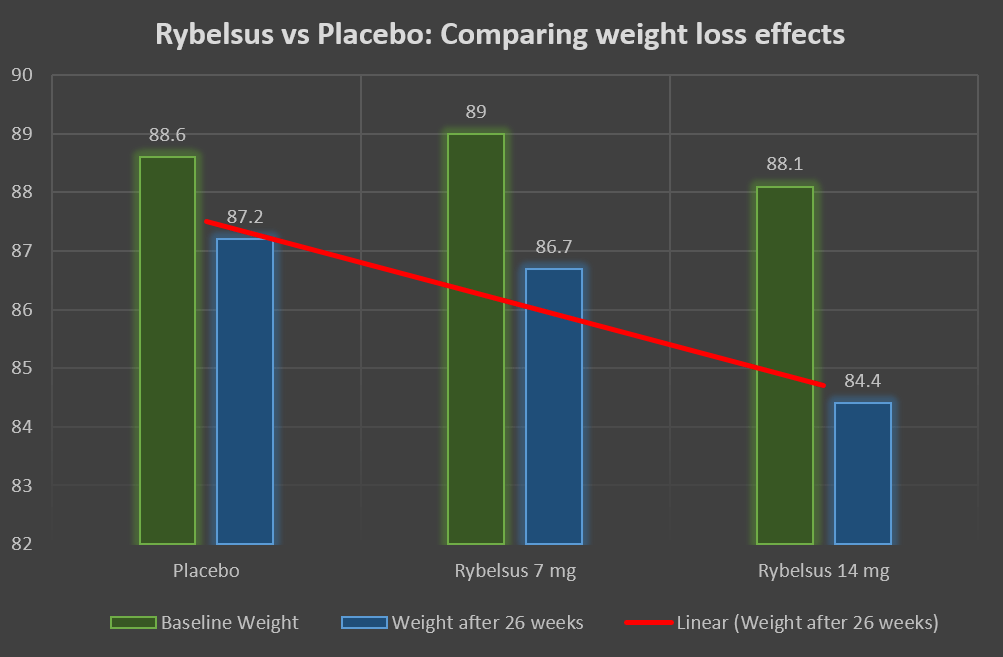Rybelsus is a class of medicines called GLP-1 analogs (Glucagon-like peptide 1). It is a new anti-diabetic medicine used to treat Diabetes Mellitus Type 2. Rybelsus has fewer side effects compared to most other diabetes medicines. Side effects are generally mild in nature and limited to the GI tract.
Rybelsus is usually prescribed by doctors when the blood sugars are not controlled with diet, exercise, and at least one or two other oral diabetes medicines have been used previously.
It is usually given with metformin or another diabetes medicine, such as an SGLT2 inhibitor (Jardiance or Farxiga).
What is Rybelsus?
Rybelsus is the oral formulation of Semaglutide and is not available under other brand names. It is available as 3 mg, 7 mg, and 14 mg tablets and is taken by mouth once daily.
Apart from being a potent diabetes medicine, it is also associated with significant weight loss. Wegovy is a high-dose injectable Semaglutide that the FDA has approved for weight loss.
The oral Semaglutide, Rybelsus, is usually administered with a glass of water on an empty stomach. If it is taken with food or other diabetes medicines, its absorption may be affected.
The oral tablets should be swallowed whole on an empty stomach without chewing, crushing, or breaking them.
To avoid side effects, it is usually prescribed in the lowest dose, i.e. 3 mg once daily. The dose is then increased to 7 mg after a month.
During this time, if the blood sugars are controlled, the same dose is continued. However, if the blood sugars are not within the range, the dose can be increased further until the maximum dose has been reached. The maximum recommended daily dose of Rybelsus is 14 mg
Rybelsus can be taken with other diabetes medicines. However, concomitant administration is avoided.
If you are on other diabetes medicines along with Rybelsus, you have to wait for at least 30 minutes after you take Rybelsus before you can take your other diabetes medicines.
What is the difference between Rybelsus and Ozempic?
Both Ozempic and Rybelsus are brand names of the active drug, Semaglutide. They can both be used by people with Diabetes Mellitus Type 2.
Rybelsus is used as a once-daily oral tablet while Ozempic is administered subcutaneously, just like insulin, once a week.
Ozempic may be more convenient for patients who have gastrointestinal symptoms and are taking multiple pills for diabetes or other concomitant illnesses.
Side effects of Rybelsus and Ozempic are comparable, however, injection site reactions can also occur with Ozempic. After injecting Ozempic, patients may notice redness, pain, or swelling at the injection site.
The usual dose of Ozempic is 0.5 mg subcutaneous once a week. However, treatment is initiated in a low dose, i.e. 0.25 mg once weekly, and is continued for four weeks.
After four weeks, the dose is then increased to 0.5 mg once a week. The maximum recommended dose of Ozempic is 1 mg subcutaneously once a week.
Efficacy-wise, there are subtle differences, however, both formulations can be used interchangeably. Ozempic is considered to reduce the risk of major cardiovascular events in patients with diabetes mellitus type, including stroke and myocardial infarction.
Rybelsus does not lower these risk factors, however, it does not increase the risk of cardiovascular events either.
What are the side effects of Rybelsus, and how to manage them?
Rybelsus can cause side effects that may range from mild to severe. Some patients may be more prone to these side effects.
To reduce the side effects, initiating treatment in lower doses and gradually increasing the dose is better.
Mild side effects of Rybelsus:
Here are some mild side effects associated with the use of Rybelsus:
- Nausea
- Belly pain
- Diarrhea
- Appetite loss
- Vomiting
- Constipation
- Weight loss
These symptoms may be minimized by starting treatment in lower doses and gradually increasing the dose at monthly intervals. If these symptoms persist, the patient must consult a healthcare provider.
Serious side effects of Rybelsus:
Serious side effects can affect a minority of patients. These side effects need to be recognized at the onset of symptoms, and immediate consultations or hospital visits are essential to prevent long-term disability or death.
- Changes in eyesight
- Low blood sugar, especially severe hypoglycemia
- kidney problems
- Thyroid cancer (Medullary thyroid cancer) BOX Warning
- Inflammation in your pancreas (Pancreatitis)
- Allergic reaction
Rybelsus Boxed Warning
Rybelsus contains a boxed warning regarding a specific type of thyroid cancer, medullary thyroid cancer.
Rybelsus may increase your chances of developing medullary thyroid cancer. However, Semaglutide (Rybelsus, Ozempic, or Wegovy) was found to increase the risk of medullary thyroid carcinoma in mice and rats.
Treatment with Semaglutide, oral or injectable Semaglutide, should be avoided in patients who have a past history of medullary thyroid cancer or are being treated for medullary thyroid cancer.
Patients with a family history of multiple endocrine neoplasia type 2 (MEN2) or a personal history of MEN2 should also avoid taking it.
What could be done?
- Inform your doctor about thyroid cancer risk. Your doctor will help you choose a safe diabetes treatment.
Rybelsus and Diabetic Retinopathy:
Diabetes can cause changes in your eyesight. Some people have experienced complications from diabetic retinopathy after taking glucagon-like Peptide-1 (GLP-1) agonists.
Diabetic retinopathy is a condition that causes damage to the eyes. You may notice blurring and changes in vision after you start treatment with an oral or injectable Semaglutide.
These effects may be transient, as occurs after rapid changes in blood glucose, or may be a direct effect of Rybelsus and persist even after the blood glucose has stabilized.
Rybelsus and Kidney Disease:
GLP-1 agonists can cause acute kidney injury, especially in people who develop nausea, vomiting, or volume depletion.
Patients must take adequate amounts of electrolyte-rich fluids to avoid volume depletion.
Weight loss with Rybelsus:
Rybelsus can cause weight loss, but it is not intended to be used as a weight-loss drug. The injectable Semaglutide, Wegovy, is primarily formulated for weight loss.
Studies showed that people who weighed an average of 196 pounds (about 99.5 kilograms) lost approximately 5 pounds (about 2 kg) over a period of six months when they took the lowest dose of Rybelsus.
It is always indicated to be used in conjunction with healthy eating habits and exercise. The patient’s diet may also be one of the main factors that can result in weight gain or weight loss.
Furthermore, apart from its direct weight loss effects, it can also cause nausea, vomiting, diarrhea, and abdominal symptoms that may result in weight loss.

What could be done?
Although weight loss associated with it is desirable in most patients, some patients may feel weaker and tired after losing weight. This is especially true when weight loss occurs primarily as a result of nausea, vomiting, or diarrhea.
Patients who have weight loss as a result of nausea and vomiting may reduce it by taking small, frequent meals (avoiding large, three-time meals)
Fluid intake must be balanced to avoid volume depletion as a result of vomiting and diarrhea.
Drink plenty of electrolyte-rich fluids to replenish your body’s fluids. You could also drink sports drinks or diluted fruit juice. Plain water will not replace electrolyte loss from vomiting or diarrhea.
Some OTC anti-diarrheal medications may be able to stop your diarrhea. A bland diet with low-fiber foods can also help to relieve diarrhea. Eating the following foods can make your stool firmer.
You can prevent weight loss by eating plenty of healthy calories. Avoid eating empty calories if you want to regain the weight you have lost.
Choose foods high in nutrients and calories. Talk to your doctor about any weight loss concerns.
Inflammation in the pancreas (Pancreatitis):
While you are taking Rybelsus, it is possible for your pancreas to become inflamed. This is known as pancreatitis.
Pancreatitis due to medication is usually mild to moderate in severity. However, severe pancreatitis can cause death in some cases.
Pancreatitis can cause severe stomach pain, nausea, vomiting, and even death. The patient may experience mild tenderness or severe pain, depending on the severity of pancreatitis. The pain is constant and can feel like a stabbing sensation. You may feel it moving towards your back.
You can reduce the discomfort by bending forward or bringing your knees up to your chest when lying down.
What could be done?
It is important to notify your doctor about past history of pancreatitis. It is also important to consult your doctor as soon as the symptoms of pancreatitis are observed.
Your doctor will examine you to determine if you have any pancreatitis before you begin the treatment.
Rybelsus, Ozempic, or Wegovy treatment should be stopped immediately if you experience persistent, severe stomach pain with or without vomiting.
Call your doctor immediately. You will likely be checked by your doctor to determine if you have pancreatitis.
You won’t be allowed to take Rybelsus if your doctor has diagnosed you with pancreatitis. You may be switched to another diabetes medicine.
Allergic Reactions:
Rybelsus may cause allergic reactions in some people. It is not known how many allergic reactions were caused by Rybelsus during studies.
Be aware of possible signs and symptoms of an allergic reaction. A mild allergic reaction may include:
- Skin rash
- Itching
- Flushing (warmth or swelling of the skin, or redness)
Although rare, severe allergic reactions are possible. A severe allergic reaction may cause swelling under the skin, most commonly in the eyelids, lips, and feet.
You may also experience swelling in your throat, tongue, and mouth. This can lead to difficulty breathing.
Patients must be informed to consult immediately in case of a severe allergic reaction.
Rybelsus use with alcohol:
Rybelsus does not interact with alcohol. However, patients must inform healthcare providers if they are taking alcohol and if it is safe to take it or not.
It should not be consumed with drinking more than 4 ounces of water. Before taking your Rybelsus dose, you should not drink alcohol.
Pregnancy and breastfeeding:
Rybelsus can cause birth defects if taken during pregnancy. However, having diabetes that isn’t well-controlled during pregnancy can be dangerous.
Talk to your doctor if you are pregnant or planning to become pregnant. They will help you weigh the risks and benefits of Rybelsus.
It is not known if Rybelsus can be found in breast milk. It is not recommended during breastfeeding.
Common concerns and questions by patients about Rybelsus:
Common questions about Rybelsus treatment are being answered here. You can add any other questions in the comments section.
What happens if I forget to take my Rybelsus dose?
- You don’t need to take extra medication to make up for the missing dose. You should wait and resume the tablets in the same dose at the next scheduled time.
Can Rybelsus be used long-term?
- Yes. It may be required for the long-term treatment of diabetes. However, regular follow-up and monitoring of blood glucose and drug-related complications are necessary.
Can you crush, chew, or split the tablets?
- No. You shouldn’t chew or crush the tablets. You should swallow it whole. If you have difficulty swallowing it, you should talk to your doctor.
Can you take Rybelsus with food?
- No. It is better to take Rybelsus at least 30 minutes before you eat your first meal of each day. You should drink no more than 4 ounces of water.
- If taken with food, beverages other than water, or other medications, it may not get absorbed properly, and the efficacy may be compromised.
What is the average time it takes Rybelsus to start working?
- It takes one to three days for the drug to become active. However, to see the full response of the drug, it may take 4 to 5 weeks.
What will Rybelsus do to my body, lifestyle, and mood?
- Various post-marketing reviews by real patients have developed anxiety and palpitations with its use.
- These symptoms may be related to low blood glucose or the gastric symptoms associated with Rybelsus. However, it is possible that the drug might directly affect mood.
- On the other hand, some people had an elevated mood, especially when they achieved good glycemic control and lost some weight.
What are the uses of Rybelsus?
- Rybelsus is a drug primarily used to treat patients with diabetes mellitus type 2.
- It is used to manage blood glucose in conjunction with exercise and healthy diabetic meals.
How does Rybelsus help to lower blood sugar levels?
- Rybelsus is a GLP-1 analog that helps lower blood glucose by increasing insulin levels. It stimulates the pancreas to release insulin when the blood glucose levels are high.
- It does not stimulate the release of glucagon. Glucagon is a hormone that activates the liver to produce more glucose.
When should I not opt for Rybelsus treatment?
- Rybelsus treatment is not indicated as the first line of treatment for diabetes mellitus.
- It is not recommended for patients with Diabetes mellitus type 1.
- It is not indicated for the treatment of Diabetic Ketoacidosis.
- Treatment is also not indicated in pregnant and lactating women.
- Other contraindications include people who are allergic to the drug, those with medullary thyroid carcinoma, and a history of pancreatic cancer or recurrent pancreatitis.
What are the factors to consider before you take Rybelsus?
- Rybelsus is best for people who are obese, have failed first-line treatment, and have insurance covering its cost.
- It should not be taken with a DPP-IV inhibitor or another GLP-1 analog such as liraglutide, dulaglutide, lixisenatide, or exenatide.
Rybelsus Interactions with other medications:
The drug’s effectiveness can be affected by taking it with other medications, vaccines, food, or other substances.
Some of the important interactions are listed here, however, you must tell your healthcare provider and pharmacist about all the drugs and herbs you are taking.
Interactions between drugs and supplements
Rybelsus slows down digestion as it delays gastric emptying. It can slow down the absorption of other drugs if taken with Rybelsus. These drugs include:
- The anticoagulants warfarin and Coumadin (Coumadin).
- The thyroid medication is levothyroxine, also known as Synthroid and thyroxine.
- The antiseizure drugs carbamazepine (Tegretol) and phenytoin (Dilantin),
- Antipsychotic medication lithium
- Digoxin (a heart medicine commonly used in patients with atrial fibrillation and low ejection fraction)
- Tacrolimus is an immunomodulator used in patients who have had a transplant.
- Other diabetes medicines such as Sitagliptin, vildagliptin, and Linagliptin.
Rybelsus may be combined with diabetes medication that lowers blood sugar. However, certain drug combinations can cause blood sugar to drop too much. Common drug combinations may include:
- Rybelsus and Insulin,
- Rybelsus and Insulin secretagogues such as sulfonylureas (glimepiride, glipizide, and glyburide) and meglitinides (repaglinide and nateglinide).
Your doctor might lower the insulin or secretagogues with Rybelsus if your blood sugar drops too low.
How much does Rybelsus cost?
Lastly, the cost is a major issue when prescribing Rybelsus to patients, especially those who do not have proper insurance coverage. Prescription drug prices can vary depending on many factors.
Prices vary depending on the dose, locality, pharmacy packages (coupons), and insurance coverage.
Rybelsus 3 mg, 7 mg, and 14 mg cost between 750 USD to 900 USD per package.
What should you do in the event of an overdose?
You should avoid overdosing on Rybelsus. In case an overdose has occurred, call your doctor immediately. Monitor your blood glucose, and keep hydrated if you have nausea and vomiting or abdominal pain.
- Premium Ingredients: Our tea blend features high-quality Berberine, aromatic Oolong, and refreshing Mint, all organicall…
- Mint Flavored: Enjoy the cool, crisp taste of mint that perfectly complements the robust flavors of Berberine and Oolong…
- Unsweetened with Zero Calories: Crafted for those who appreciate the natural flavors of tea, our blend is completely uns…
- One package of 72 cherry-flavored Gas-X Extra Strength Chewable Gas Relief Tablets with Simethicone 125 mg for bloating …
- Gas-X simethicone gas relief tablets relieves gas in minutes and offers bloating relief
- Gas-X antigas chewable simethicone tablets provides fast gas relief and bloating relief, rescuing you from embarrassing …

- HealthA2Z Gas Relief Simethicone Maximum Strength softgels provide fast relief of gas buildup, painful bloating and dige…
- Goes to work in minutes. Easy-to swallow softgels.
- Use for relief of pressure, bloating, and fullness commonly referred to as gas.

- One 50 ct package of Gas-X Maximum Strength Gas Relief Softgels with Simethicone 250 mg; number 1 Anti-Gas Relief
- Gas-X simethicone softgels provide fast gas and bloating relief
- Gas-X antigas provides fast bloating and gas relief, rescuing you from embarrassing situations and helping you get back …











